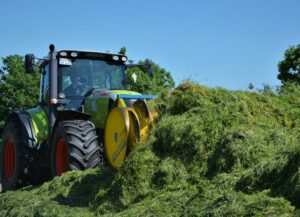Alvaro Garcia
Corn grain has a high starch concentration and as such is used as energy source for cattle diets in many parts of the world. This starch is also used in the industry as a substrate to produce ethanol and sweeteners. Ethanol extraction from corn concentrates results in all other valuable nutrients being concentrated.
As a result, corn grain which has originally 7-9% crude protein concentration, once starch is extracted leaves a coproduct with much higher protein concentration (> 30%). The two most common corn starch processing methods in the industry today are dry milling (ethanol production) and wet milling (sweetener production), with both leaving high protein coproducts.
From ethanol production the coproduct obtained is distillers dried grains which has a crude protein (CP) concentration between 27-30%. The sweetener industry on the other hand, leaves corn gluten feed (25% CP) and corn gluten meal (60% CP).
More recently (1990’s), further fractionation has removed the fat, bran, and germ of the kernel further increasing the CP of the remaining coproduct to 40% CP or more. There is a novel proprietary high protein product with close to 56% CP that’s also available as a protein concentrate, particularly for dairy cattle.
There has not been a large body of research of these new fractionation coproducts, particularly compared to other, more traditional alternatives such as soybean meal and canola meal.
Lysine and methionine as limiting amino acids
Aside from any differences in total CP these concentrates have also differences in their amino acid profiles that match animal requirements to a variable degree. Lysine and methionine are the most limiting, and again variable, depending on the original grain used. Corn is particularly limiting in lysine compared to soybean meal, while canola meal has higher concentrations of methionine, which is very low in soybean meal. There is a need then to assess how these deficiencies affect dairy performance when one of these products replaces the other.
A recent experiment (Brown and Bradford. 2020) looked at milk production and nitrogen digestibility responses of high-producing Holstein cows after replacing common protein sources with a high-protein corn coproduct. The supply of metabolizable methionine and lysine was maintained constant across diets.
Holstein cows with 111 ± 34 days in milk and producing 52 kg/day milk with 3.6% fat and 3.1% protein, were randomly assigned to treatments in a replicated 4 × 4 Latin square design. Cows were fed individually and for 28 days one of four diets ad libitum, which included a different protein concentrate:
- Soybean meal
- High-protein corn coproduct (56.1% CP)
- Soybean meal with rumen-bypass soy protein (soybean bypass protein)
- Canola meal with rumen-bypass soy protein (canola bypass protein)
Diets were isonitrogenous and balanced for lysine and methionine requirements. The soybean meal supplemented diet was formulated to provide 5.7% rumen-undegradable protein (RUP), whereas soybean bypass protein and canola bypass protein diets were formulated for 6.8% RUP to match the high protein corn coproduct.
Cows received a base TMR with the treatment top-dressed and mixed by hand at each feeding. Diets were formulated for equal CP concentrations and balanced to meet the requirements of metabolizable lysine (79.5 g/d) and methionine (225 g/d). The diets provided equal concentrations of forage fiber and starch.
Cows fed the high protein corn coproduct diet produced less milk
Cows fed the high protein corn coproduct diet produced less milk and milk components, they also consumed less CP and had lower apparent total-tract and CP digestibility. It is possible that during the production process the coproduct suffered some excessive heating (Maillard reaction) that reduces its digestibility.
The soybean bypass protein and canola bypass protein diets performed similarly when they were balanced for methionine and lysine supply. This confirmed that canola meal is a viable substitute for soybean mean when prices are competitive.
The canola bypass protein diet increased dry matter intake compared with the soybean meal and high protein corn coproduct diets. Treatment affected milk production, with soybean bypass protein and canola bypass protein fed cows producing more compared with soybean meal diets, but high protein corn product decreased milk production compared with all treatments.
The high protein corn coproduct diet also decreased apparent total tract and CP digestibility, this resulted in less nitrogen excretion in urine and greater fecal nitrogen output. The soybean bypass protein and canola bypass protein diets performed similarly with the exception that that soybean bypass protein increased milk urea nitrogen.
In conclusion, the high protein corn coproduct diet reduced yield of milk and milk components, likely because of reduced digestibility.
Reference
W. E. Brown, B. J. Bradford. 2020. Effects of a high-protein corn product compared with soy and canola protein sources on nutrient digestibility and production responses in mid-lactation dairy cows. J. Dairy Sci. 103:6233–6243.
© 2020 Dairy Knowledge Center. All Rights Reserved.











